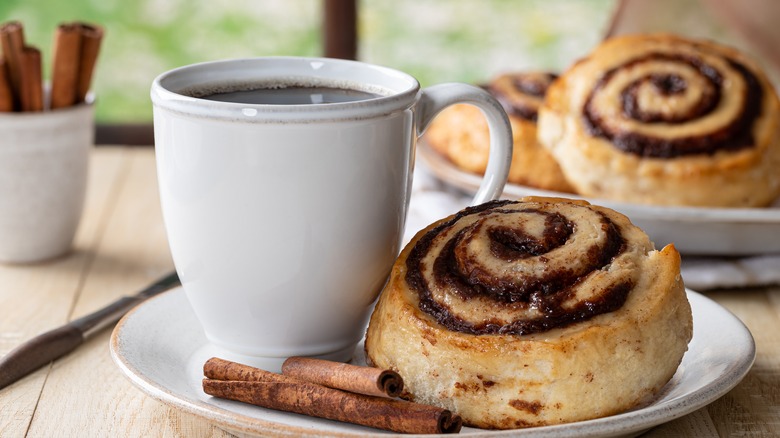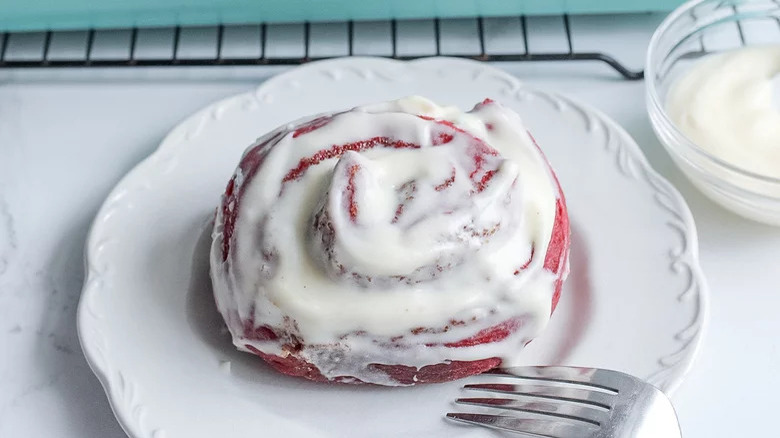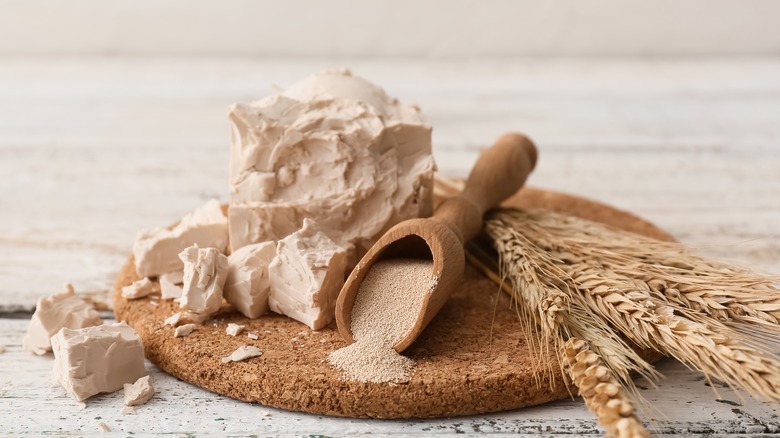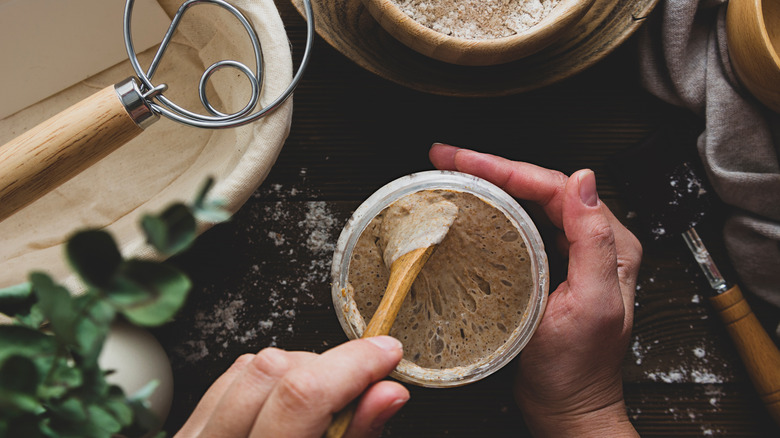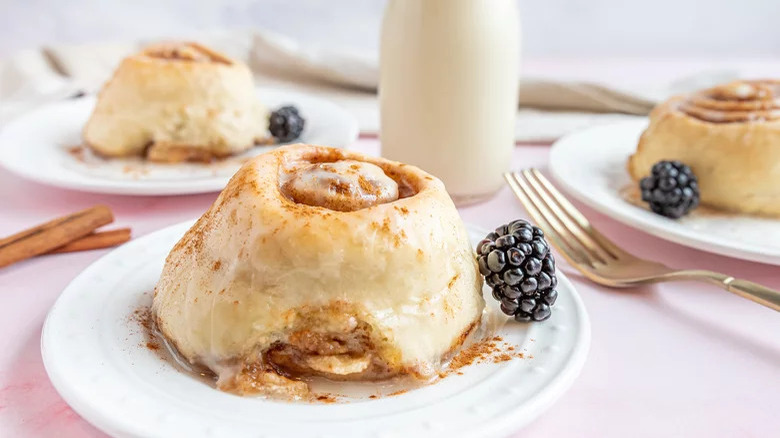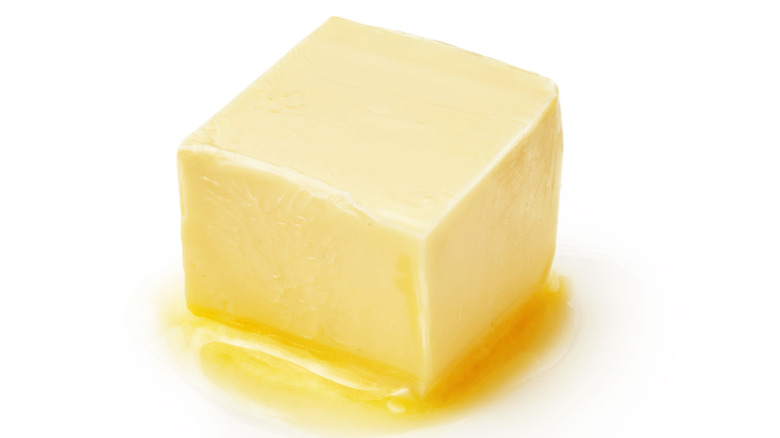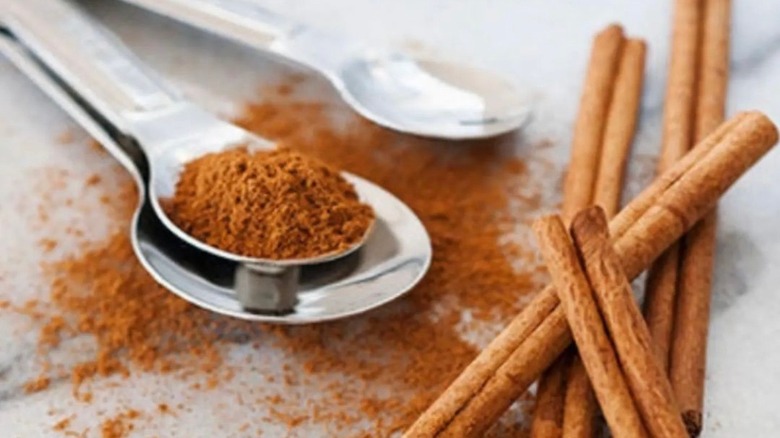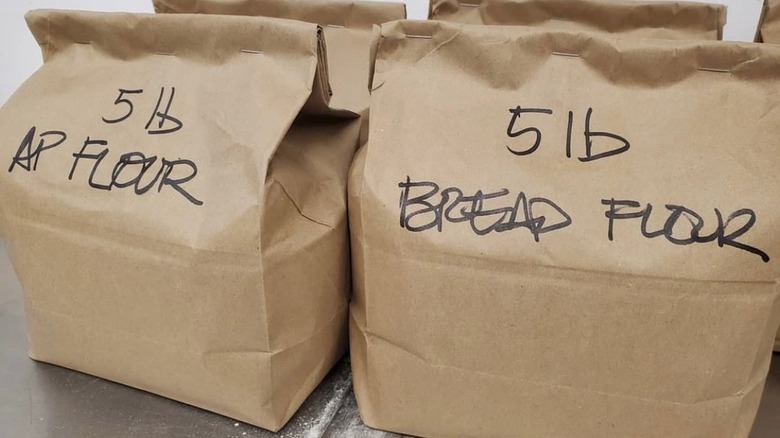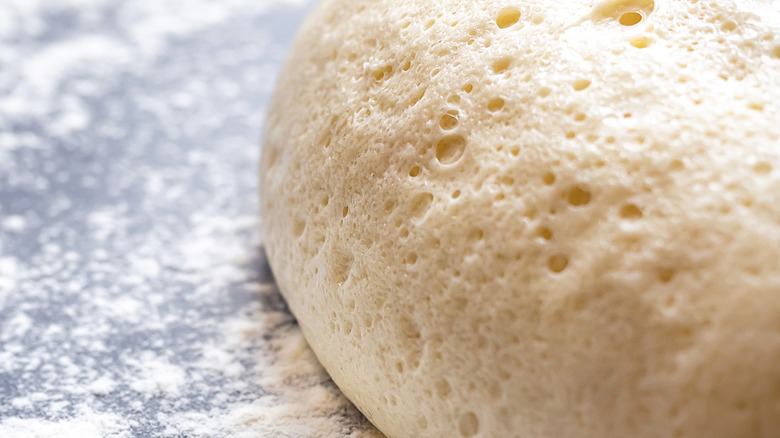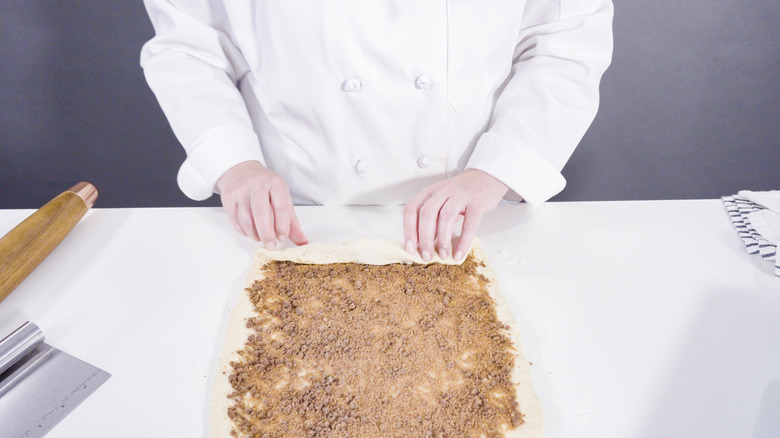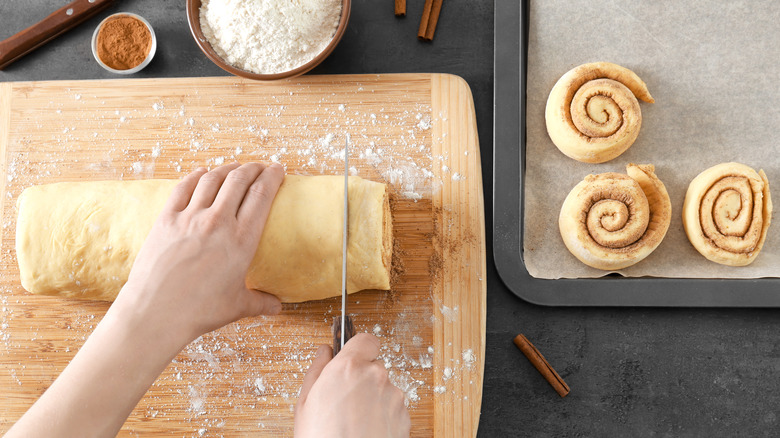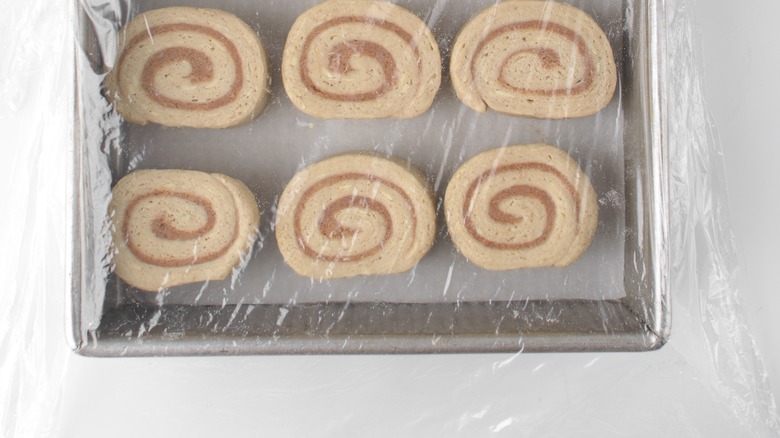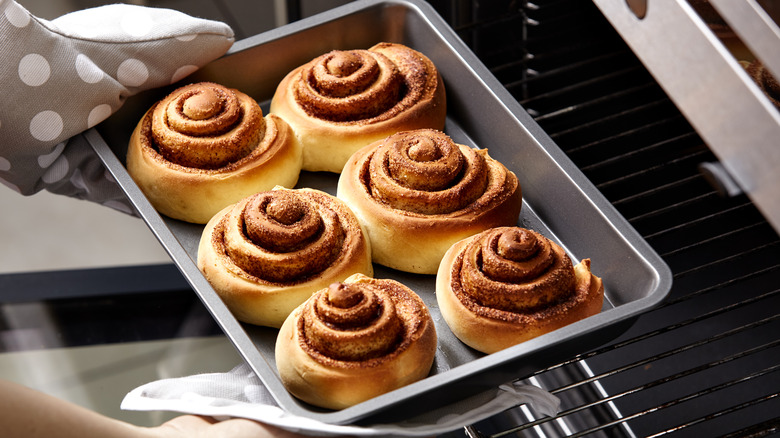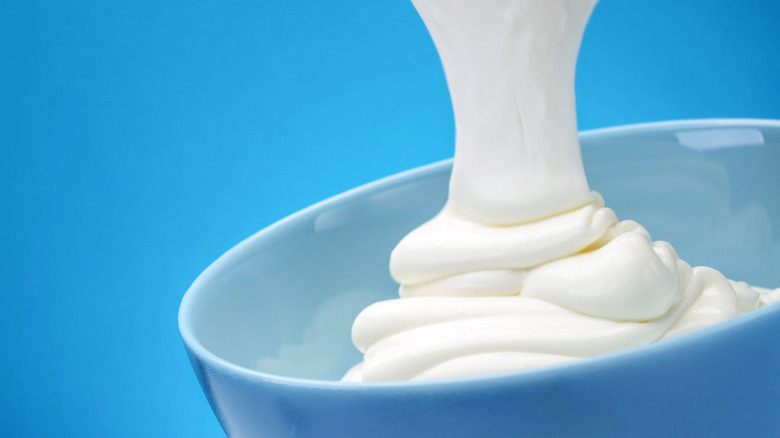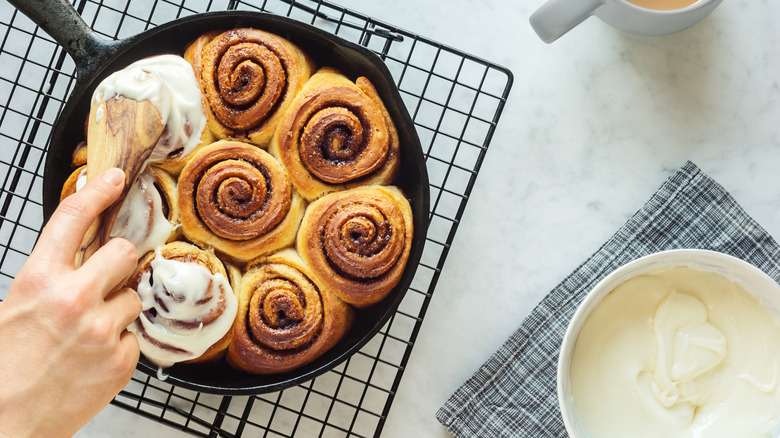14 Mistakes You're Making With Cinnamon Rolls
Cinnamon rolls are, with no doubt, the king of breakfast pastries. In Sweden, the first types of cinnamon rolls were called kanelbulle; these treats were so profound that the country elected the fourth of October as the food's national holiday (via Bakerpedia). Swedish cinnamon rolls are much lighter than American cinnamon rolls and are often spiced with cardamon.
Food historians believe the first cinnamon rolls arrived in America following Swedish and German immigrants in the 1600s. The rolls became popular in the Southern states and eventually extended across the nation. There are some regional variations on the cinnamon roll recipe, including Philadelphia cinnamon rolls — which are sweetened with honey, sugar, cinnamon, and raisins, says LeafTV. There are also variations in the topping of these rolls. The Nordic cinnamon roll has sprinkled pearl sugar rather than icing. American recipes utilize a thick, sweetened cream cheese icing or a thin vanilla glaze.
No matter what way you prefer your cinnamon rolls, there are always things you can do better to make the best possible cinnamon rolls at home. Here are some of the most common mistakes in cinnamon roll baking and how you can fix them.
Sticking with the same conventional cinnamon roll recipe
There is more to cinnamon rolls than just cinnamon. One of our favorite ways to upgrade cinnamon rolls is to completely revamp the recipe into something more cake-like. You can make red velvet cinnamon rolls at home with the simple addition of a boxed red velvet cake mix. Combine the boxed mix with flour, yeast, and sugar to create the same soft cinnamon roll experience. Once the dough has risen, add the typical mix of brown sugar, cinnamon, and melted butter to create your filling. The resulting dough will be pillowy, and soft, and have the perfect cinnamon roll texture.
The only thing you need to make the red velvet rolls more decadent is to include a thick cream cheese icing. The perfect cream cheese icing combines cream cheese, butter, vanilla, and sugar. When storing these rolls (if the whole tray is not already gone), you should save some icing. After reheating the rolls individually, spread on additional icing and enjoy.
Using the wrong kind of yeast
With all of the different kinds of yeast on the market, how do you pick the perfect type for your cinnamon rolls? We should first start by distinguishing the kinds of yeast used in cinnamon roll recipes. The two most common types include active dry yeast (ADY) and instant yeast.
Active dry yeast is powdered yeast that needs to be "bloomed" before it can be mixed into the dough. To bloom this type of yeast, stir the designated amount of yeast into warmed water or milk and granulated sugar and wait for five minutes. A fruity smell from the cup ensures the yeast is active, healthy, and ready to rise. Instant yeast does not require mixing and instead can be added directly to the dough. For baking, we prefer instant yeast because it takes much less time to rise the dough than active dry yeast. This time difference is due to the small particle size of the instant yeast, as well as the addition of accelerant agents in the instant yeast packets. If you plan to make overnight cinnamon rolls, active dry yeast may still be an option.
Not using a sourdough starter
A sourdough starter is no doubt the key to a flavorful dough. Strictly using powdered yeast in your dough will result in a lackluster flavor because commercial yeast is not dependent on a rich flora of wild bacteria and yeasts like sourdough. Sourdough is cultured from a "starter" grown over a period of weeks — you can purchase a starter or make one yourself. Once the starter is created, you'll need to steadily discard parts of the starter to make room for new flour (and growth).
Use your sourdough discards to flavor your next cinnamon roll recipe. Sourdough cinnamon rolls will usually require a bit of starter and yeast to speed up the rising reaction time and keep your cinnamon rolls soft and pillowy. You can add your starter and commercial yeast to the dough and let it proof overnight, or use a greater proportion of commercial yeast if you just want the slight tang of the sourdough.
Avoiding experimenting with fats
The perfect, soft cinnamon roll is really dependent on a lot of fat. You'll often see recipes with butter as the primary fat, but there is a whole world of fats outside of this dairy-based option. If you want to make vegan cinnamon rolls, you should consult a stick of vegan butter. The vegan butter resembles the flavor of dairy-based butter but is usually crafted from a blend of plant oils. Another option for vegan cinnamon rolls is coconut oil. Refined coconut oil does not have the same undertone of coconut as unrefined (or "raw" coconut oil), so this is preferable for a non-tropical flavor.
If you want to substitute coconut oil for butter in cinnamon rolls, make sure to either keep the coconut oil in a solid state or melt it depending on the recipe. You can use coconut oil for butter with a 1-to-1 ratio for both solid and liquid applications.
Using hard butter or melted butter
The key to making a perfectly ooey, gooey cinnamon roll isn't about the spice — it's about the butter. When you are preparing cinnamon rolls, you should always work with slightly softened butter rather than rock-hard or melted butter. In a dough, the butter is an important softener that keeps the dough supple. If you melt the butter, it will leak out of the dough as it bakes. Butter that is too hard will leave pockets in the dough after it melts. We want Goldilocks butter — right in the middle.
Before you prepare your cinnamon rolls, leave your butter out at room temperature. You don't have to worry about the food safety risk of this because the butter is usually pasteurized and it will get cooked in the oven eventually anyways. You'll know the butter is at the perfect consistency when you can easily slice through it with a butter knife. If you need softened butter in a pinch, place a stick of butter underneath a glass. The ambient heat will soften the butter perfectly.
Not using different kinds of cinnamon
Did you know there are many different types of cinnamon used in cooking? The most common type of cinnamon used for recipes like cinnamon rolls is cassia cinnamon. This cinnamon is commonly labeled as "ground cinnamon" in American and Canadian grocery stores. The flavor of the cassia cinnamon is mostly sweet, with a comparatively mild scent. Ceylon cinnamon is endemic to Sri Lanka and Madagascar. Ceylon has a much more floral undertone than cassia cinnamon and appears less red in color. You can look for Ceylon cinnamon in the spice aisle of your grocery store or purchase the type from online retailers. We recommend trying Ceylon in your recipe for a novel cinnamon experience.
You should opt for ground cinnamon for the most powerful cinnamon flavor in your baked goods. Cinnamon sticks are used for infusing cinnamon flavor into hot liquids (like teas) but don't always impart the same flavors you want from ground cinnamon.
Using a weak flour
Cinnamon rolls are a glutenous yeasted bread, so most cinnamon recipes will ask for bread flour or high-gluten wheat flour (or a mix of all-purpose flour and high-gluten bread flour). Flours with high gluten ensure that the dough can develop a strong structure while it is kneaded. Cake flour, on the other hand, has low gluten and is usually reserved for pastries where denseness is detrimental.
There are not a lot of excessive precautions you need to take when working with bread flour in lieu of all-purpose flour — just focus on kneading to develop the gluten in the flour. Some recipes with bread flour tend to be a bit drier (since the water gets sucked up by all those gluten strands), so you may need to adjust the dough hydration slightly. If you do not have access to high-gluten bread flour for your cinnamon roll recipe, you can make your own at home with vital wheat gluten and all-purpose flour. You can combine 1 cup of flour with just over 1 teaspoon of vital wheat gluten. Sift the two together using a kitchen sieve and voila!
Not letting your dough double in size
The trick with cinnamon rolls is not to rush the rising process. If your cinnamon rolls are coming out of the oven dry and dense, the rolls are telling you that you didn't adequately rest the dough before baking. During the first rise, your dough should at least double in size. If your dough doesn't double in size, you may be looking at other issues in your baking methodology — including inactive yeast. Your dough might also be too hard if you added too much flour and not enough hydration to boot.
One test to see if your dough is proofed enough is to poke it. The dough should indent slightly if it is properly rested and ready to be shaped. Dough that deflates completely or doesn't change its shape is either under or over-proofed. If the dough is over-proofed, you can still bake it — just expect a more stodgy and dense texture.
Overfilling your cinnamon rolls
Cinnamon rolls are always easy to overstuff. To avoid leaking butter and brown sugar onto your baking sheet (which has the potential to burn and set off your kitchen smoke alarm), you need to be vigilant of how much cinnamon sugar filling you're adding to the rolls. As a general frame of reference, you should always leave at least an inch of space between your filling and the sides of the dough after it's rolled. You only need a light sprinkle of the cinnamon sugar filling in the dough.
Another tip to avoid overfilling your cinnamon rolls is to try and keep your rolling as tight as possible. This will prevent the sugar from falling through the cracks into the dough and onto the baking sheet. After the dough is rolled, pinch along the seam of the dough to prevent the rolls from unraveling when you are cutting.
Haphazardly slicing your cinnamon rolls
The number one rule of both cooking and baking is to make sure everything is equally sized. This ensures an even bake across the whole batch. When you're cutting cinnamon rolls, you may be tempted to just eyeball the sizing of your rolls. Not only is failure inevitable with this method, but you will also get very frustrated with the uneven edges and shapes that a knife produces.
The King Arthur Baking Company has a solution to this problem — and it can be found in your bathroom cabinet. Use unflavored (again, we emphasize unflavored) floss to slice your cinnamon rolls. After your dough has been rolled, pinched at the seams, and is ready to go, slide a piece of floss under the dough. Slicing in 2-inch intervals (measure with a ruler), pull the floss upwards and in opposite directions, slicing the dough. The cinnamon rolls should plop down on your baking surface with ease.
Skipping the final proof before the oven
Most doughs require not one, but two rest periods. The first stage is the rising period — which is done before the dough has been shaped. The second resting stage is called proofing and occurs after the dough has been shaped. The exact time of both the first rise and the second proof is dependent on the ambient environment of the room (since warmer spaces cause the yeast to be super active), as well as the condition of the dough.
When making cinnamon rolls (as well as other types of bread), having a second proof after the cinnamon rolls are shaped is critical to developing a good texture. The King Arthur Baking Company recommends placing your formed cinnamon rolls in a round cake tin and covering them with plastic wrap or a damp tea towel for the second proof. Both of these methods seal in the moisture of the dough as its proofing.
Not giving your cinnamon rolls enough space in the oven
Cinnamon rolls are notably very elastic and stretchy. As the dough bakes, it will expand and cover more space than you'd think. If you want perfectly-cooked cinnamon rolls, you need to give enough space for the rolls to expand during baking. When cinnamon rolls rise up like tiny volcanos, your rolls are telling you that you need more space. The resulting texture of the volcanos will be dense and underbaked in the middle and overbaked on the exterior rings.
If you use a pull-apart cinnamon roll recipe, you should allocate at least an inch of space on all sides of the rolls (it's counter-intuitive to the name — we know). Stand-alone cinnamon rolls on a baking pan can stand upwards of 2 inches of space on all sides. The resulting cinnamon rolls will be perfect, equally cooked, and above all — delicious.
Not adding yogurt to the recipe for moisture
The perfect cinnamon roll is moist and easy to make at home. With the addition of Greek yogurt to your cinnamon roll, you'll find the rising time of the dough to be dramatically shortened and the texture of the dough to be super soft and supple. A Greek yogurt cinnamon roll recipe can get cinnamon rolls on your table in less than 30 minutes (hello easy breakfast). If you prepare the dough in advance, it will last a few days in the refrigerator or months in the freezer.
You can add all the ingredients to your cinnamon rolls, along with the Greek yogurt, into a stand mixer. The Greek yogurt replaces the yeast, so you won't have to worry about any resting or proofing. If you want a more tangy yogurt flavor, make your own icing by combining plain vanilla yogurt and powdered sugar.
Using icing from a can
Don't just settle for canned frosting when you're going through the process of making homemade cinnamon rolls. Canned frosting, albeit convenient, is much thicker than icing. Most frosting is held together with fat (like butter), cream cheese, or egg whites. Frosting will not move on the cinnamon roll and will be a little denser to bite into than icing. The primary ingredient in icing is not fat, but powdered sugar. The easiest way to make powdered sugar is to combine it with a scant amount of liquid.
The primary liquid used in icing is milk, but you can use liqueurs or flavored juices to add novelty to your cinnamon roll icing. Make a dairy-free icing with organic or certified-vegan powdered sugar and plant-based milk. If you want thick icing with the tang of cream cheese, you can make a cream cheese frosting by combining cream cheese with powdered sugar and whipping until smooth.
